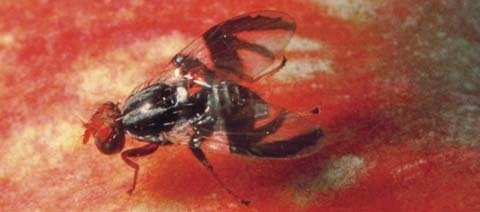 Apple maggot is not difficult to control, but it is a serious problem if found in orchards because it’s a quarantine pest.
Apple maggot is not difficult to control, but it is a serious problem if found in orchards because it’s a quarantine pest.
Apple maggot is native to the eastern United States. It was first noticed in northern Oregon in 1979 and has since spread through western Washington as far as the border with Canada, Tim Smith, Washington State University Extension educator, explained at the Lake Chelan Horticultural Day.
It was found in Spokane in eastern Washington in 1982 and during the past decade has spread to Washington’s main apple-producing regions in central Washington. In 1995, it was found in Yakima, and two years later in Ellensburg and Kennewick. In 2000, a single apple maggot fly was trapped in an ornamental hawthorn tree in the Wenatchee cemetery, Smith said. In the fall of 2005, the Washington State Department of Agriculture found an infested tree in the same neighborhood.
Like its relative, the cherry fruit fly, apple maggot will be an important pest to control, Smith said. It will not be a damaging pest, but because of its status as a quarantine pest, growers might have to put on extra sprays.
Black hawthorn is its native host. The insect can fly into orchards from nearby hawthorn. It prefers to attack fruit that is soft, Smith said. Apples that ripen early in the year are particularly susceptible, while pears might not be susceptible until after harvest. In Utah, the pest has been reported attacking tart cherries.
The maggot has a similar life cycle to cherry fruit fly, though it is active about a month to five weeks later. It overwinters as a pupa in the ground. The pupa is about the size of a grain of wheat. Adults emerge from the ground over an extended period of time in the summer. About seven to ten days after emerging, they mate, and females lay eggs under the skin of the fruit. Young maggots that hatch from the eggs spend about a month boring around inside the flesh of the fruit, causing it to decompose. Mature larvae leave the fruit, burrow into the soil to pupate, and emerge as adults the following year.
Management
Smith said traps are not very attractive to apple maggot flies, so trapping is not a very good monitoring method unless there are high populations.
Apple maggot rarely survives in orchards that are sprayed with pesticides. It is very common in cities where there are hawthorn trees. Hanging traps in hawthorn trees near orchards might provide a hint of when the flies are around, Smith said.
Success (spinosad) and the organic formulation Entrust are fairly good for controlling apple maggot, as is the GF-120 bait, which contains spinosad. GF-120 has been used successfully to control cherry fruit fly but might not give adequate protection from apple maggot where flies are moving into the orchard from outside sources, Smith said.
Most materials used for codling moth, including insect growth regulators, will also control apple maggot, whose emergence coincides with the second generation of codling moth. Fruit flies don’t seem to develop resistance to pesticides, Smith said.

Leave A Comment